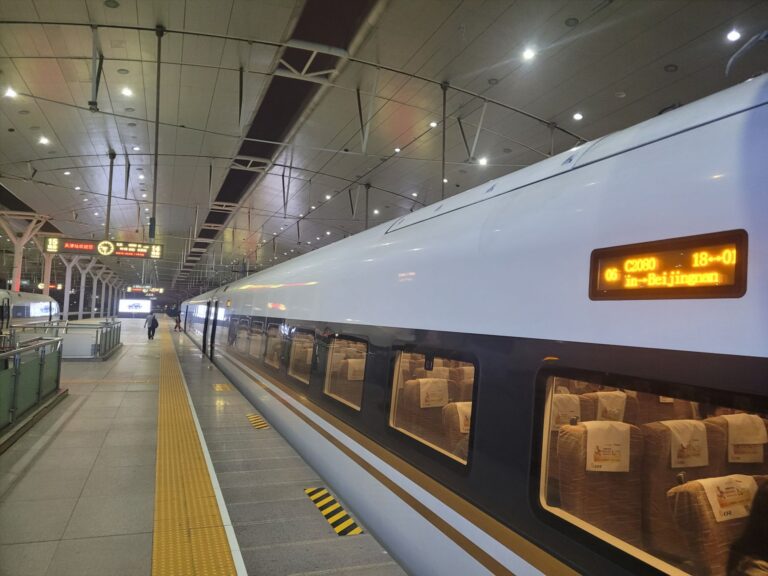Picture this: You’ve just arrived in the mountains. The air is crisp, the view is breathtaking (literally), and you’re ready for the adventure of a lifetime. But then it hits: a pounding headache, a wave of nausea, and a strange, heavy fatigue. Welcome to altitude sickness – a totally preventable travel spoiler.
The great news? With some prep, you can greatly reduce your risk and know what to do if symptoms arise. This guide is your companion to understanding, preventing, and managing altitude sickness – so you can focus on the adventure! In this guide, we’ll explain what altitude sickness is, how to recognize the signs, and how to prevent and manage it like a seasoned adventurer.
I decided to write this article when I couldn’t find many resources on altitude sickness when I started planning my trip to Yunnan, China with my family earlier this year, including with my elderly grandma, which got me to do more research on this topic.
⛰️ 1. What Is Altitude Sickness?
Altitude sickness, also known as acute mountain sickness (AMS), is your body’s reaction to climbing too high too fast. As elevation increases, the air gets thinner and contains less oxygen. For most people, the body adjusts over time – a process called acclimatization. But if you ascend too quickly, your body may struggle to adapt. Trouble usually starts above 2,500 metres (around 8,000 feet), though some feel it lower, especially with rapid ascent.
The Forms:
- Acute Mountain Sickness (AMS): The mildest and most common form, like a hangover with a headache, nausea, and fatigue – something like a hangover if you need something to compare it to
- High-Altitude Pulmonary Edema (HAPE): Fluid leaks into the lungs, causing breathlessness.
- High-Altitude Cerebral Edema (HACE): Swelling in the brain, leading to confusion and loss of coordination. This is life-threatening.
📈 2. At What Altitude Does Altitude Sickness Start?
Most people start to feel symptoms above 2,500 meters (8,000 feet). But susceptibility varies widely. Some people feel fine at 3,500m, while others experience symptoms at 2,400m.
Factors that increase your risk include (more on this below):
- Rapid ascent (especially flying directly into a high-altitude city)
- Sleeping altitude: Sleeping high without acclimatization is riskier than just visiting during the day
- Overexertion early in your trip
Examples of High-Altitude Destinations:
- Yunnan, China (e.g., Shangri-La): 3,200 m (10,500 ft)
- La Paz, Bolivia: 3,650m (11,975 ft)
- Cusco, Peru: 3,400m (11,150 ft)
- Lhasa, Tibet: 3,650m (11,975 ft)
- Everest Base Camp: 5,364m (17,598 ft)
✳️ 3. Who are at risk? Key Factors for Altitude Sickness
Anyone can get altitude sickness, no matter how fit you may think you are (in fact you may be likelier to overexert and push yourself), but your risk increases if:
- You ascend too quickly (This is the biggest culprit!) Especially if you live at sea level (like myself) and make a sudden jump to high altitude
- Your sleeping altitude is high without prior acclimatization (ie ascending too rapidly without any rest days).
- You’ve had altitude sickness before
- You exert yourself heavily immediately upon arrival
- You have certain pre-existing conditions (especially heart/lung issues – always consult your doctor before travel if this is you).
😖 4. How to spot the symptoms
AMS symptoms typically appear 6-10 hours after arrival at altitude (can be sooner or up to 24 hours).
- The “Altitude Hangover” Clues:
- Headache is the #1 symptom.
- Nausea or vomiting.
- Fatigue and weakness.
- Dizziness or light-headedness.
- Difficulty sleeping.
- Is it AMS? It can mimic dehydration or a cold, but AMS usually lacks fever.
- Golden Rule: At altitude, if you feel unwell with a headache, assume it’s AMS until proven otherwise.
🟥5. RED FLAGS! When to Descend IMMEDIATELY & Seek Urgent Help
Severe altitude sickness (HACE or HAPE) is a medical emergency.
- Severe Headache: Unresponsive to painkillers.
- Persistent Vomiting.
- Worsening Fatigue/Weakness.
- Confusion, Disorientation, or Irrational Behavior.
- Loss of Coordination (Ataxia): Stumbling, difficulty walking straight (like being drunk). Critical sign of HACE.
- Severe Shortness of Breath Even at Rest. Key sign of HAPE.
- Persistent Cough: Especially wet, gurgling, or producing frothy/pink sputum. Key sign of HAPE.
- Bluish Lips/Nails (Cyanosis).
- Extreme Drowsiness or Difficulty Waking.
Do not wait. Do not try to “tough it out” and think that it will go away by itself and you will adapt. DESCEND. I CANNOT EMPHASIZE THIS ENOUGH. Immediate descent is lifesaving. If symptoms worsen despite rest, or if ANY of these appear, DESCEND AT LEAST 300-1,000m (1,000-3,300ft) and get medical help:
💪🏻6. Prevention: is always better than cure
🐿 Go Slow and Steady – give your body time to adjust
- Don’t ascend more than 500m (1,600 ft) per day once above 3,000m
- If possible, spend a night at an intermediate altitude (1,500-2,500m / 5,000-8,000ft) first.
- Add a rest day for every 1,000m gain
🗺 Climb High, Sleep Low
- Hike to higher elevations during the day, but return to a lower place to sleep.
💧 Hydrate (But Don’t Overdo It)
- Dehydration worsens AMS. Aim for 3-4L of water/day.
- Aim for pale urine.
- Don’t force fluid if you’re not thirsty, or if you have medical conditions that predispose you to fluid overload (consult your doctor)
❌ Avoid Alcohol and Sleeping Pills
- Both suppress breathing and make symptoms worse.
- They also mess with your sleep quality.
🏡 Rest Every Few Days
- Easy First 24-48 Hours: Avoid strenuous activity upon arrival at a new, higher altitude.
- Build in acclimatization days during multiday treks.
- Use that day to relax, take shorter hikes, and let your body catch up.
💊7. Medications That Can Help: When to Pack a Pill Bottle
Preventative medication might be an option for rapid ascents or if you have a history of AMS. This requires a discussion with your doctor. Please also follow the above prevention tips even if you have medicine on hand.
- Acetazolamide (Diamox):
- How it helps: Speeds up natural acclimatization.
- Typical Dose: 125mg twice daily, starting the day before ascent and continuing for a few days at your highest altitude.
- Side Effects: Common, harmless tingling in fingers/toes, altered taste of fizzy drinks.
- Prescription Only: Not for everyone; your doctor will assess suitability.
- Ibuprofen
- How it helps: Some studies suggest it may help prevent AMS, but it’s less established than Diamox for prevention. Helps with headaches and inflammation. Can reduce AMS symptoms moderately
- You may hear about natural options depending on the places you visit but these have limited evidence
❗8. What to Do If You Get Altitude Sickness
STOP! Do NOT Go Higher. This is non-negotiable until symptoms resolve.
If symptoms are mild:
- Rest, hydrate, and take ibuprofen or paracetamol
- Avoid further ascent until symptoms resolve (usually 24-48 hours)
- Eat lightly
- Make sure you tell someone about your symptoms
If symptoms worsen or persist:
- Descend at least 500-1000m
- Don’t try to “push through” it
- Consider using oxygen or medications (with medical advice – eg. if acetazolamide if prescribed)
If signs of HAPE or HACE develop:
- Immediate descent is lifesaving
- Use portable oxygen if available
- Call for emergency evacuation if necessary
❓9. Altitude Sickness FAQ
Q: Aim I at increased risk if I am older?
A: People aged over 50 years may have slightly less risk of developing altitude illness. But you have to consider the other medical conditions that you may have given your age.
Q: Can I predict my risk?
A: Genetics play a role, there are no simple screening tests available.
Q: Can I fly into a high-altitude city and be fine?
A: Maybe. Many people feel symptoms after 6–24 hours. Rest on Day 1 and don’t plan strenuous activities.
Q: Should I take medications even if I’m healthy?
A: Consult your doctor. It helps if you’ve had altitude issues before or are going above 3,000m quickly.
Q: What if I’ve had AMS before?
A: You’re more likely to get it again. Acclimatize properly and consider preventive meds.
Q: Can kids get altitude sickness
A: Yes, but symptoms may be harder to detect. Watch for changes in behavior, appetite, and sleep.
Q: Aiya I’m not climbing up Everest, it won’t happen to me?
A: It can occur at many popular tourist spots above 2,500m – see the examples above.
📚 Further Reading & Trusted Resources
For more detailed information on altitude illness, check out these sources:
Conclusion
Mountains are awe-inspiring, humbling, and unforgettable. But they also demand respect.
Altitude sickness is not something to fear, and don’t let fear stop you. Make sure you understand and prepare for the risks beforehand, start checking on the altitude of the places you visit. With slow ascent, smart planning, and a watchful eye on yourself and your companions, you can explore the world’s highest places with confidence.
The view from high up is always better when you’re feeling your best.
Planning a trip to Yunnan, Andes, Himalayas, or East Africa? Bookmark this guide and share it with your fellow adventurers!

Disclaimer: The information in this blog post is for general informational purposes only and does not constitute medical advice. It is essential to consult with your personal physician or a qualified travel medicine specialist before your trip to discuss your individual health needs, risks, and any preventative measures or treatments for altitude sickness. This post is not a substitute for professional medical advice, diagnosis, or treatment. If you experience severe symptoms at altitude, seek immediate medical attention.







2 Comments